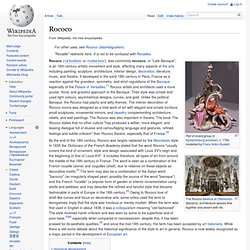

Cupola. In architecture, a cupola /ˈkjuːpələ/ is a small, most often dome-like, structure on top of a building.[1] Often used to provide a lookout or to admit light and air, it usually crowns a larger roof or dome.[2][3] The word derives, via Italian, from the lower Latin cupula (classical Latin cupella from the Greek κύπελλον kupellon) "small cup" (Latin cupa) indicating a vault resembling an upside down cup.[4] Inside of Armenian Orthodox church cupola in Lviv, Ukraine.Cupolas were also used on some old barns for ventilation.

The cupola is a development during the Renaissance of the oculus, an ancient device found in Roman architecture, but being weatherproof was superior for the wetter climates of northern Europe. Rococo. Rococo (/rəˈkoʊkoʊ/ or /roʊkəˈkoʊ/), less commonly roccoco, or "Late Baroque", is an 18th-century artistic movement and style, affecting many aspects of the arts including painting, sculpture, architecture, interior design, decoration, literature, music, and theatre.

It developed in the early 18th century in Paris, France as a reaction against the grandeur, symmetry, and strict regulations of the Baroque, especially of the Palace of Versailles.[1] Rococo artists and architects used a more jocular, florid, and graceful approach to the Baroque. Their style was ornate and used light colours, asymmetrical designs, curves, and gold. Unlike the political Baroque, the Rococo had playful and witty themes. The interior decoration of Rococo rooms was designed as a total work of art with elegant and ornate furniture, small sculptures, ornamental mirrors, and tapestry complementing architecture, reliefs, and wall paintings.
The Rococo was also important in theatre. Free Bibliography Maker - MLA, APA, Chicago citation styles.